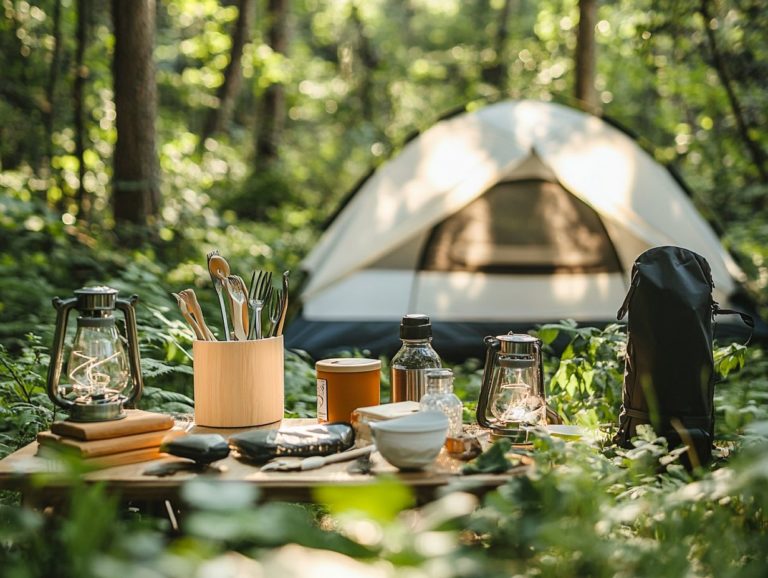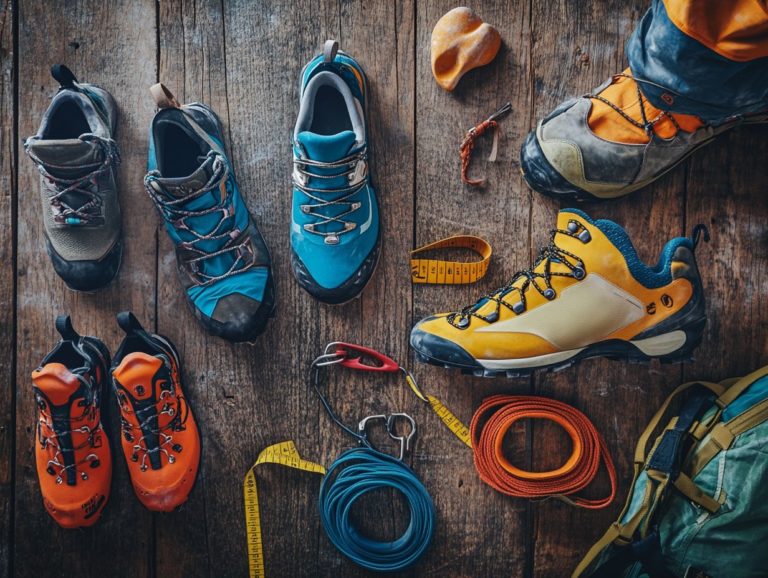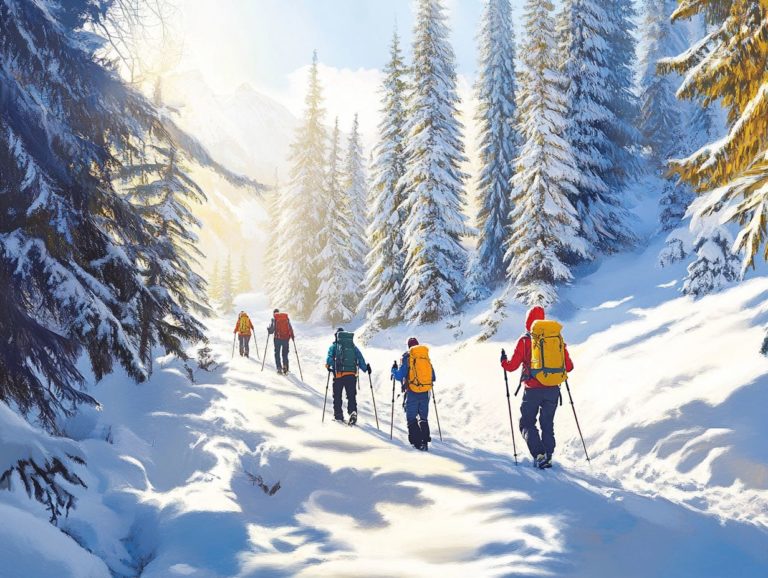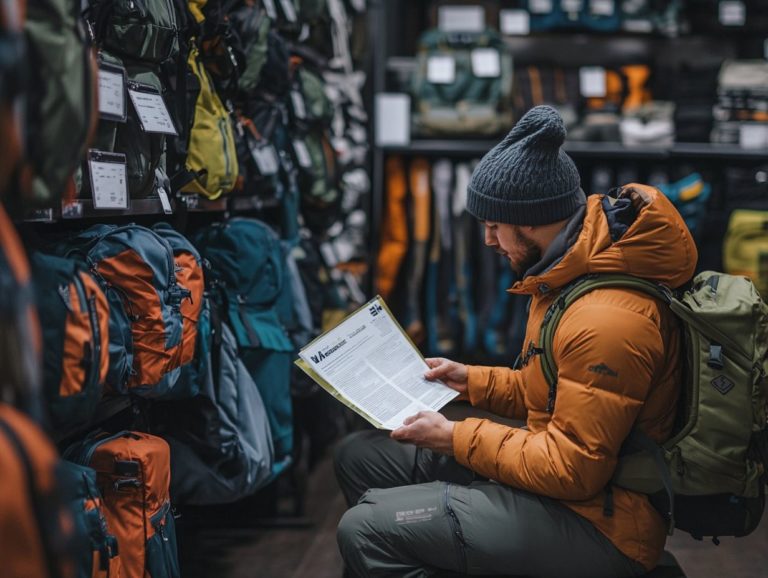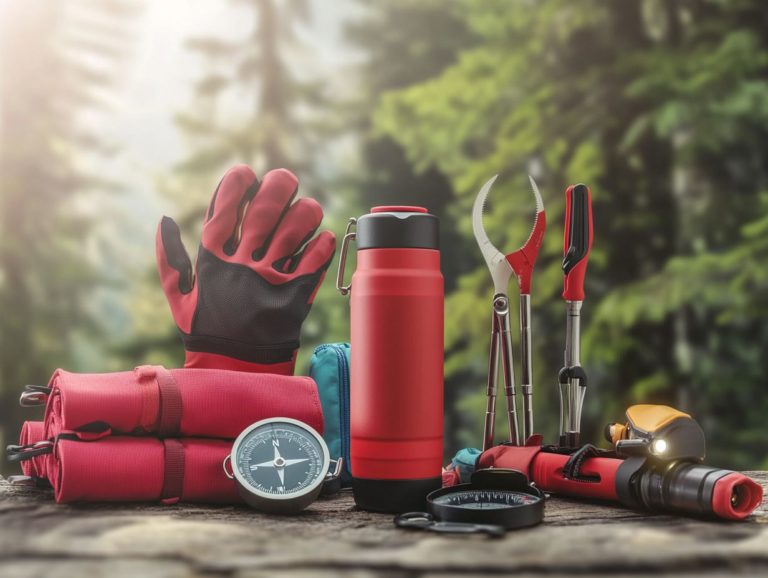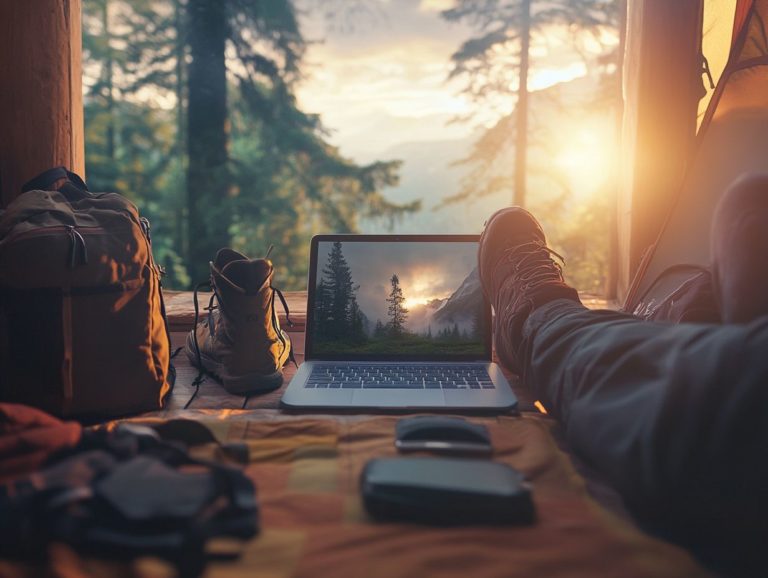What Gear Do I Need for Snow Climbing?
Snow climbing presents an exhilarating opportunity to immerse yourself in the winter landscape. Having the right gear is crucial for ensuring both safety and success.
This guide delves into the essential and optional equipment necessary for conquering snowy ascents. From ice axes to climbing harnesses, each item will be carefully looked at, providing insights on how to select the appropriate gear for different conditions and offering maintenance tips to keep everything in top shape.
Get ready for an unforgettable snowy adventure that awaits you!
Contents
Key Takeaways:
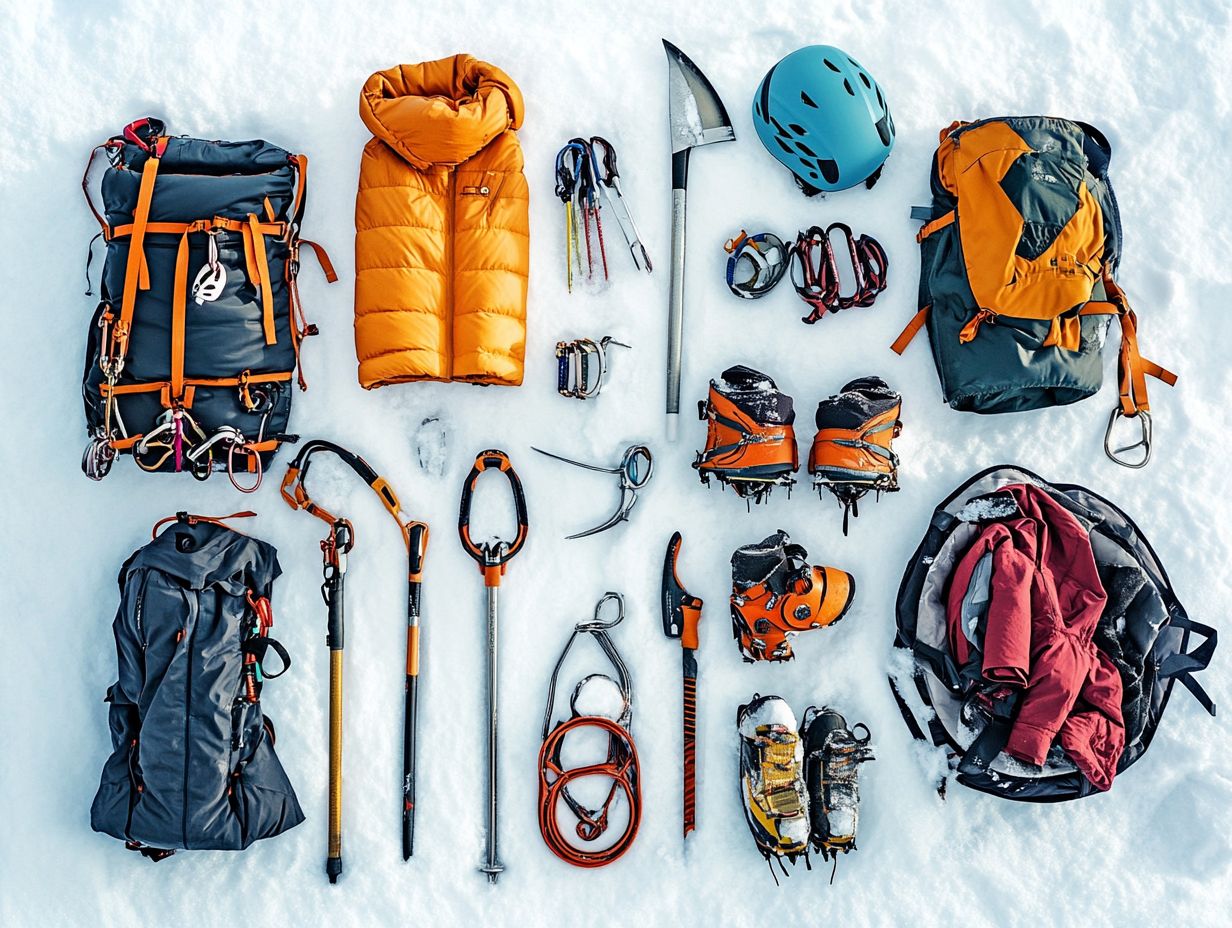
- Safety comes first when snow climbing. Essential gear such as an ice axe, crampons, and a helmet should always be used to protect against falls and injuries.
- Choose gear based on the specific climbing conditions. Optional gear like snowshoes, mountaineering boots, and ice screws can provide additional stability and support in different terrains.
- Maintenance and care of gear is crucial for a successful climb. Regularly inspect and properly store gear to ensure it is in good condition and safe to use for future climbs.
What is Snow Climbing?
Snow climbing is an exhilarating outdoor pursuit that merges the thrill of mountaineering with the unique challenges of a winter landscape. As you navigate icy and snow-laden terrains, you’ll employ specialized techniques and equipment that elevate the experience beyond simply reaching a summit.
Understanding the nuances of weather conditions and adapting to the distinct demands of the mountain environment is essential. Proper training is crucial, along with a keen awareness of climbing strategies and the right gear for winter camping, for tackling snow-covered routes safely and effectively.
Unlike rock climbing or ice climbing, snow climbing requires mastering the art of navigating snow-blanketed slopes. This often involves skills such as snow anchoring and avalanche awareness. This captivating adventure beckons outdoor enthusiasts, lured by breathtaking landscapes and the adrenaline rush from conquering frosty peaks.
Preparation is key. You must condition your body and familiarize yourself with snow-specific techniques. Prioritizing safety is paramount, as unpredictable weather patterns and shifting snow conditions can introduce significant risks.
Engaging in comprehensive outdoor training not only sharpens your climbing skills but also deepens your appreciation for the wilderness.
Essential Gear for Snow Climbing
When you embark on a snow climbing adventure, having the right equipment is essential for your safety and performance. The gear you ll need is a blend of technical climbing tools and winter-specific items that are built to endure harsh conditions.
Each piece of equipment serves a critical purpose providing insulation, ensuring stability, or aiding navigation in challenging environments. Thus, grasping the key components of your climbing gear is vital for anyone aiming to conquer snowy terrains with confidence.
Ice Axe
The ice axe is an essential tool for you in snow climbing. It serves multiple purposes such as self-arrest (which means using your ice axe to stop yourself from sliding down), protection, and navigation on icy surfaces. This versatile piece of technical climbing gear is crucial for maintaining your stability and safety, whether you’re traversing steep slopes or preparing for a climbing route.
Different types of ice axes cater to your specific climbing needs, ranging from general mountaineering models with a balanced design for various terrains to more specialized tools meant for technical ice climbing. Typically, they consist of a shaft, pick, and adze, allowing you to tackle different encounters with ice and snow.
To ensure optimal performance, proper handling is crucial. This means maintaining a secure grip and understanding the angle of placement for effective self-arrest. Regular cleaning, inspecting for wear or damage, and proper storage will extend the lifespan of your tools, boosting your confidence and safety on those steep, icy slopes.
Crampons
Crampons are absolutely essential for your snow climbing adventures, providing the traction you need on icy surfaces and boosting your climbing efficiency. With various designs available, including C1 crampons for general use, these devices help you maintain stability as you navigate challenging terrains.
Choosing the right crampons is vital. Factors like how they attach to your boots and the type of terrain you ll encounter matter. When fitted properly, crampons become an extension of your feet, allowing for safe and confident movement across snow and ice!
The terrain itself can influence your choice whether you need a more aggressive grip, like C2 or C3 crampons, which are ideal for mixed or technical climbs. Understanding what gear is required for rock climbing can elevate your ability to tackle various climbing conditions with ease and confidence.
Helmet
A climbing helmet is an essential piece of snow climbing gear you simply can’t overlook! It’s designed to protect your head from falling debris and impacts as you ascend. In the unpredictable world of winter sports, a reliable helmet does more than just safeguard you; it enhances your comfort and fit during those lengthy climbs.
When you pick a helmet, consider how light it is for comfort, its ventilation for cooling, and its durability for safety. Make sure the helmet meets safety standards, like UIAA or CE certification, which confirms its reliability in protecting you against severe impacts. By prioritizing these elements, you can confidently select a helmet that meets your needs and elevates your overall climbing experience!
Climbing Harness
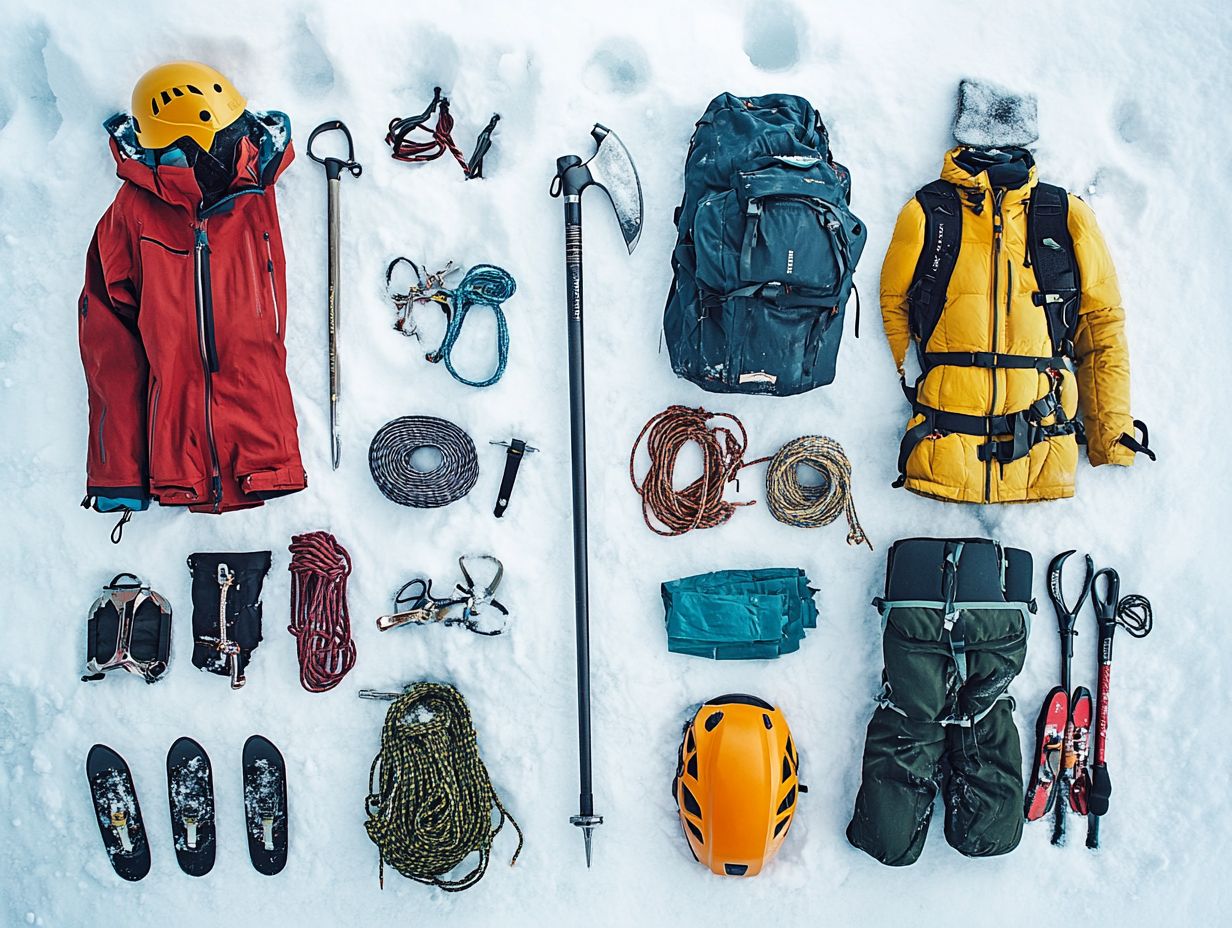
A climbing harness is an essential piece of equipment for you! It keeps you safe by attaching you securely to safety systems while navigating challenging snowy terrains. It also distributes your weight evenly and provides the necessary support for rappelling or ascending.
You can choose from sport, trad, or full-body harnesses, each made for different climbing needs. Sport harnesses often feature a lightweight design, while trad harnesses come with additional gear loops to carry your essential equipment. If you’re a beginner or need extra security, full-body options ensure there’s no chance of inversion during a fall.
Make sure to adjust the leg loops and waist strap snugly! You should fit a finger between the harness and your body for safety and comfort. Striking that perfect balance of security and comfort is paramount to enjoying your climbing adventures safely.
Belay Device
Belay devices are vital in snow climbing as they help you manage the rope safely and efficiently during both ascents and descents. These tools empower you to control your descent, provide protection against falls, and enhance your overall climbing safety. Choosing the right belay device is crucial for ensuring that you and your belayer feel secure throughout the climb.
Understanding the various types of belay devices can profoundly influence your climbing experience. You ll encounter tube-style devices, which offer a straightforward yet effective mechanism for handling the rope, and assisted-braking devices that help slow your fall automatically, providing an added layer of security.
Each device is tailored for different climbing styles, whether you re tackling sport climbing, traditional routes, or alpine challenges. Regular practice with your selected device is wise, cultivating familiarity with its operation.
Always remember to double-check your connections, maintain clear communication with your climbing partner, and adhere to essential safety protocols. Creating a secure and enjoyable climbing environment is essential for your thrill and safety!
Protective Layers
Protective layers in snow climbing include essential components like base layers, thermal underwear, and insulation layers. These layers shield you from cold and wet conditions while efficiently wicking away moisture. A well-structured layering system keeps you warm and enhances your mobility, allowing you to concentrate on your ascent without the weather becoming a distraction.
For your base layer, choose moisture-wicking fabrics like merino wool or high-quality synthetic fibers. These fabrics excel at managing sweat and preventing chills. Opt for lightweight insulation options such as midweight fleece, down vests, or softshell pants that trap heat effectively without adding unnecessary bulk. This intelligent layering strategy is key to regulating your body temperature as you shift between exertion and rest.
Consider fabrics that provide both breathability, like GoreTex, and thermal protection, allowing sweat to escape while keeping the cold air at bay. Ultimately, investing in a quality layering system transforms your climbing experience into something far more enjoyable and significantly safer.
Optional Gear for Snow Climbing
While essential gear is crucial for snow climbing, consider incorporating several optional items, such as hiking socks, waterproof windproof jackets, and waterproof rucksacks. These can elevate your experience and enhance safety as you navigate snowy terrains. These additional gear pieces not only offer extra safety features but also provide comfort and convenience tailored to specific climbing conditions.
Carefully selecting the right optional gear can dramatically impact your overall performance and security during challenging winter adventures. To learn more about the best equipment, check out different types of climbing gear. Gear up today and elevate your snow climbing experience to new heights!
Snowshoes
Snowshoes are an invaluable addition to your snow climbing gear. They are designed to distribute weight evenly and prevent you from sinking into deep snow. By using snowshoes, you can traverse snowy landscapes with greater efficiency, especially in less technical areas where traditional climbing gear might not be necessary. This choice allows you to conserve energy and maintain better footing during challenging hikes.
These innovative tools come in various types, from recreational models perfect for casual strolls to specialized options suited for backcountry adventures. Each type features unique characteristics, including different sizes and materials that optimize performance depending on snow conditions and terrain.
For the best experience, choose snowshoes that align with your weight, the depth of the snow, and the activity you have in mind. Keeping a few best practices in mind can elevate your snowshoeing experience:
- Select the right footwear to ensure maximum comfort during your snowshoeing adventures.
- Learn proper techniques for ascending and descending hills to improve your safety.
- Familiarize yourself with the terrain to enhance safety and enjoyment while you explore snow-covered trails.
Mountaineering Boots
Mountaineering boots are essential for snow climbing. They provide support, warmth, and waterproof features for tackling snowy terrains with confidence.
Quality boots ensure traction and insulation for icy slopes and wet snow. Choosing the right pair boosts your safety and performance.
When selecting your boots, consider insulation to keep your feet warm. Fit is also crucial for comfort and reducing blisters on long climbs.
Opt for waterproof boots for protection against the elements. Ensure compatibility with gear like crampons for a secure fit.
Pay attention to the boot’s sole stiffness. This greatly influences your traction on rocky surfaces and improves stability in challenging terrains.
Ice Screws
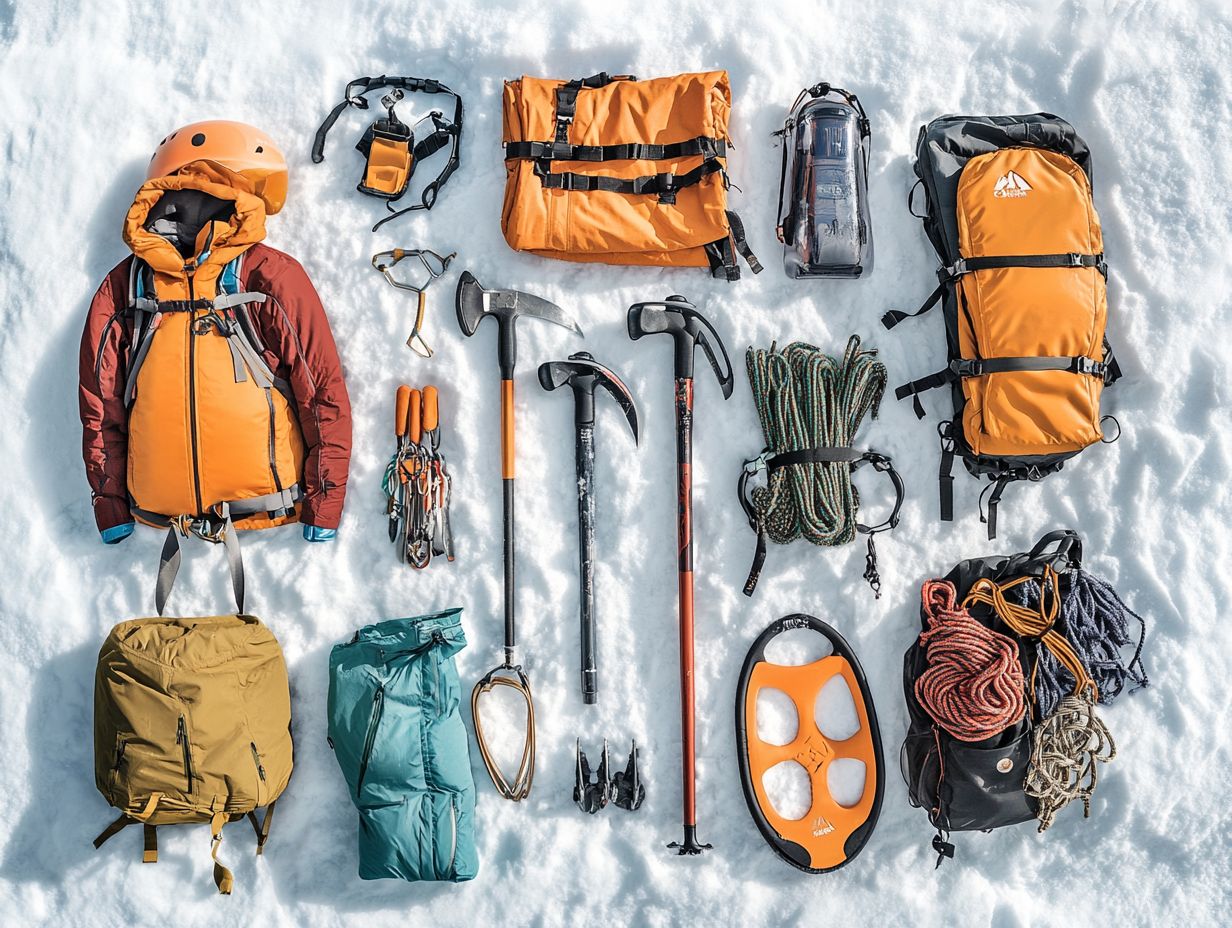
Ice screws are important for climbing on snow and ice. They provide secure anchor points in icy conditions, acting as your lifeline on steep terrain.
Mastering the correct placement of these screws is crucial for your safety during the ascent. You’ll find various ice screws tailored for specific conditions.
Short screws are lightweight and ideal for moderate ice. In contrast, longer screws provide enhanced holding power for thick ice formations.
The beauty of ice screws lies in their easy removability and repositioning. When placing a screw, rotate it clockwise until it bites into the ice.
Retrieve them with caution to avoid dislodging surrounding ice. Understanding these nuances gives you the power to make informed decisions.
Avalanche Safety Gear
Avalanche safety gear is crucial for any snow climber. It offers essential tools to detect and respond to avalanche risks.
Typical equipment includes avalanche beacons, probes, and shovels. Each tool is vital for ensuring safety in potentially hazardous conditions.
Beacons help locate buried individuals quickly. Probes pinpoint their exact location, while shovels are essential for excavation and building emergency shelters.
Having the right gear is just one part of avalanche safety; training is equally important. Attend avalanche safety courses to learn essential skills.
By combining the right equipment with thorough training, you can mitigate risks associated with avalanches.
Tips for Choosing and Using Snow Climbing Gear
Choosing snow climbing gear requires attention to safety, comfort, and environmental challenges. It’s crucial to understand the essential gear and how to maintain it properly.
Being well-informed empowers you to maximize your safety and performance. Thoughtful gear recommendations guide you through challenging conditions for an exceptional climbing experience.
Considerations for Different Climbing Conditions
Different climbing conditions, such as hiking conditions and weather conditions, can significantly influence your choice of gear and techniques in snow climbing. It’s crucial to evaluate the environment before embarking on your ascent.
For example, fluctuating temperatures can change the characteristics of the snow, turning light powder into a firmer surface. This shift may necessitate the use of specific types of crampons to enhance your traction. Heavy snowfall can conceal hidden hazards and elevate the risk of avalanches. To ensure safety, it’s crucial to know what gear you need for hiking and carry advanced safety equipment like transceivers, which are devices that help locate people in case of an avalanche, and probes for added security.
The steepness and type of the terrain, whether icy slopes or mixed conditions, will also dictate whether you need lightweight tools or more robust gear. Understanding the best gear for solo climbers can also help you stay prepared. By staying attuned to these factors, you can effectively prepare and adapt your techniques, ensuring your experience in the mountains is both secure and enjoyable.
Proper Maintenance and Care
Taking care of your snow climbing gear, including personal items like comfortable trousers and warm hats, is essential for safety and extending the lifespan of your equipment. Regular checks, cleaning, and effective storage practices can dramatically influence the performance and reliability of key items like crampons, harnesses, and helmets.
Start by routinely inspecting your equipment for signs of wear, such as frayed straps or rusted components these can pose serious safety risks. Cleaning your gear after each outing is just as crucial. A simple wash with warm water and mild soap can effectively remove salt and debris, particularly from metal parts.
After cleaning, ensure everything is thoroughly dried before storage, as moisture can lead to corrosion. When your gear isn’t in use, store it in a cool, dry place preferably in a designated storage bag to shield it from environmental factors that could degrade its performance.
By adhering to these best practices, including proper care for outdoor equipment and cold weather gear, you not only keep your equipment in peak condition but also elevate your overall climbing experience.
Frequently Asked Questions
What gear do I need for my snow climbing adventure?
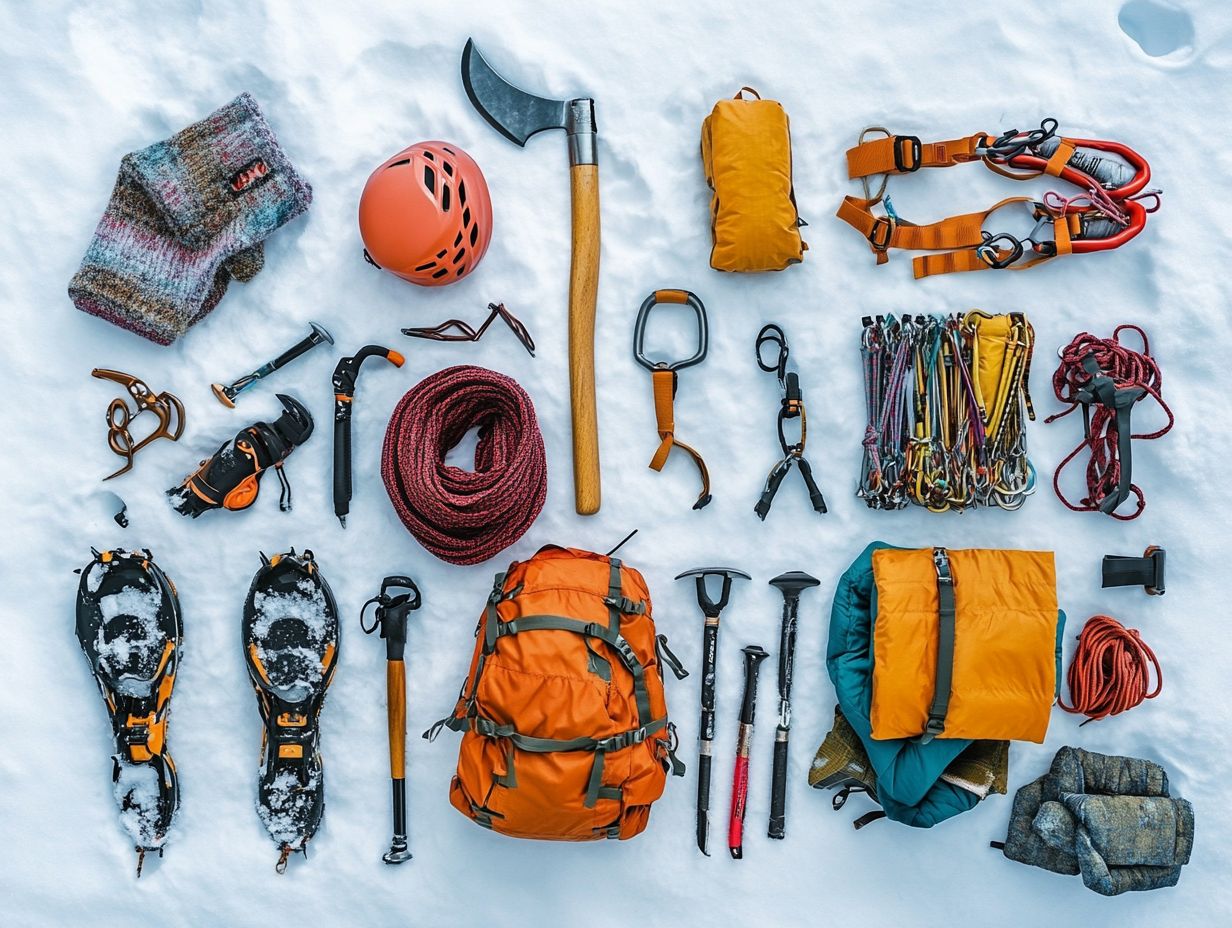
You need a specific set of gear for snowy conditions, including:
- Ice axe
- Crampons
- Helmet
- Ropes
These tools will help you navigate through icy and steep terrain while keeping you safe.
What type of clothing do I need for snow climbing?
You will need to dress in layers to keep your body warm and dry. It is recommended to wear:
- A moisture-wicking base layer
- A mid-layer for insulation
- An outer layer to protect against wind and moisture
Don’t forget a warm hat, gloves, and waterproof boots!
Do I need any special training for snow climbing?
Yes, it is highly recommended to undergo proper training and education before attempting snow climbing. This includes learning how to use your gear, understanding avalanche safety, and mastering techniques for climbing on snow and ice. Taking a course or going with an experienced guide can greatly increase your chances of success and safety.
What type of backpack do I need for snow climbing?
Your backpack should be large enough to carry all your necessary gear and supplies but not too bulky to hinder your movement. Look for a pack specifically designed for snow climbing with features such as ice axe loops and attachment points for ropes. It should also have a comfortable and adjustable fit to distribute weight evenly.
Ready to take your snow climbing to the next level?
How do I prepare for a snow climbing trip?
Besides having the right gear, you need to prepare well for your snow climbing trip. Snow climbing, which involves scaling snowy terrain, requires careful preparation.
Check the weather, study the route, and pack enough food and water. Also, inform someone about your plans.
Always check the conditions to stay safe and enjoy your adventure!

